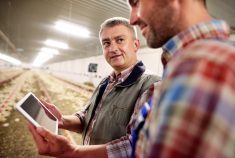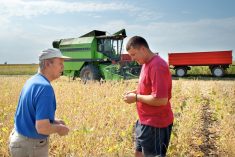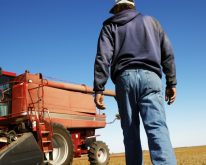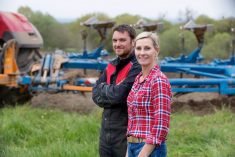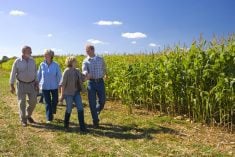On-farm leadership is more than the skills we usually think of when defining a leader. This article looks at what farm leadership is really about.
– April Stewart, CG Associate Editor
When we think of strong leaders we often leap to examples like politicians, sport coaches and the CEOs of large corporations, so it’s little surprise that our ideas of leadership can be mixed in with the skills it takes to manage large groups of employees, or to chair meetings or grab the microphone like a great orator.
Read Also

Youth focused on keeping Quebec’s dairy industry strong
In part two of our Making the Future series, Country Guide spoke with Béatrice Neveu from Rawdon, Que. (Read part…
On the farm, though, leadership needs to involve even more than that.
When you think of successful farms, the vast majority in Canada have only a few, mostly related members, yet all those farms have great leadership. Their business leaders make great decisions — strategically, thoughtfully and bravely. And although these same farmers may not always be the loudest voices in the community or in their commodity groups, they’re communicating well within their smaller family-based teams and they have strong relationships with suppliers, buyers and advisers.
Which is why, even on the farm, communication skills are increasingly being seen as essential components of leadership.
Being able to engagingly lead a farm business and to clearly articulate your goals can no longer be thought of as just a one-way, top-down process, says Richard Stup, a Pennsylvania-based business leadership expert who works with small businesses, including farms, to develop leadership skills and human resources management.
Business leadership isn’t some trait you inherit or something you mysteriously absorb by living on a farm, says Stup, who grew up on a farm himself and has a masters in agricultural education and a PhD in workforce management.
Nor is it something you get by drinking a magic potion as a kid. Instead, it’s something you work at, Stup says. “Leadership for your farm business is about creating a culture and systems to use resources more efficiently, and of course that takes motivated people.”
In Canada, meanwhile, while taking his MBA at Western University’s Ivey School of Business, Steve Koeckhoven learned leadership skills that he’s been able to bring home to the family farm near Wolseley, Sask., and also to his work off-farm for Agrium in Calgary.
“My experience in agriculture is lifelong, and the MBA has definitely helped me weave my way through my career off-farm and on the farm,” the 34-year-old Koeckhoven says.
In retrospect, he now adds, the most significant lessons he took back to the farm started with learning how essential listening is for problem solving, and how important leading teams is to his own performance.
And there’s another lesson too, he says. “Ninety per cent of leadership is communications.” As with most such programs, the MBA at Ivey required listening to lectures, but the program is also heavily weighted toward group work and case studies. Teams of four or five classmates analyze and develop solutions for each scenario.
Koeckhoven was the lone farmer in a class full of international professionals who came with all sorts of undergraduate degrees and aggressive, go-getter personalities, plus high levels of intelligence.
In that environment, they all had to learn to actively listen to the group. “I got so many insights into ways to attack a problem if I listened to the others in the group.”
On the Koeckhoven family farm, meanwhile, three strong-willed successful men were trying to work together. Steve and younger brother John now farm with their parents, Harry and Anika. Like the MBA case study groups, everyone was trying to have input into everything on the farm, and rarely did they really listen to the others. Voices got louder, more aggressive and at times even ended up in arguments.
Koeckhoven remembers a time when he got a loaded grain truck stuck exactly where his brother had told him not to drive. He hadn’t listened. His mom actually videoed the ensuing crazy interaction and showed them later, trying to make everyone laugh at themselves.
However, her underlying message struck him as he participated in the case study groups: the three Koeckhoven men needed to figure out a better way to work together. To be successful and happy working together, they needed to really listen to each other, instead of pretending to listen, maybe even nodding and all the while thinking of something else.
Create a fearless culture
Whether you want to or not, as a leader you will create a culture on your farm. “When I’m at the farm at my desk, life seems so much simpler, less complicated, than it is when I’m in my office in downtown Calgary,” Koeckhoven says with a sigh. “It’s a good life.”
The Koeckhoven Farms culture is focused on profitability, but family comes first and all parties respect that there’s life outside the farm as well. Koeckhoven says this “just try it” attitude likely comes from his parents immigrating to Canada in the ’80s with three children in tow. They bought a dairy farm in Alberta, even though their experience in Holland was grain farming.
But Harry had understood the economics of supply management and how it made sense financially. “Dad milked his first cow at 40 years old,” says Steve.
Over the next decades, Harry and Anika steadily expanded the herd from 20 to 125 cows and the Koeckhoven kids grew up milking cows, all while also being taught to be curious about things other than farming.
Steve earned his bachelor of commerce in finance from the University of Alberta and only during the last year did he take his electives in agriculture. It was that taste and his parents’ passion for farming that spurred him to switch to agricultural economics to do his masters on cost of production and management of resources, with his first job out of university working as an agricultural consultant with MNP.
At home, Steve and his dad also crunched numbers to see if it made financial sense to fulfil his dad’s dream of grain farming in Canada. The culture of smart, out-of-the-box thinking drove the process.
In the early 2000s they took the plunge, selling the cows, quota and Alberta farmland and buying a farm in southern Saskatchewan. Today they own, crop-share and rent about 5,500 acres.
In addition to themselves and the two brothers working on the farm on holidays, they hire one man in the summer — an agricultural college graduate who is respected by the whole family. Although they pay him over market wages, Steve says hiring the right match for their farm is worth it.
“Leading employees is more than not bossing them around or retention, it’s respecting how much they bring to your farm,” he says.
The next step
Steve says today’s successful farmers need to understand how important engaged people — employees, family owners, suppliers and advisers — are to the continued growth of their business.
He isn’t alone. “I find the 30- to 40-year-olds are a different generation, with a different mindset and have a different approach to business management,” says Stup.
Farmers, like any other business people who produce stuff, tend to be focused on production, he finds, yet he repeats that leading your farm business is actually about creating a culture and systems to use resources more efficiently, and of course that takes communication and motivated people.
If the leaders are disengaged, non-communicative, and don’t care about their employees, that becomes the culture for the business.
To Stup, it’s clear: “If the farmer doesn’t like managing people, doesn’t like building teams, then they need to hire someone who likes managing people.”
“Leadership is all about developing a culture, and leaders set the culture, ” he says.
Your strategy
At the heart of any successful farm today is a base strategy, but it has to be communicated among everyone involved.
Almost all farms have multiple partners, from two spouses to multiple family members to non-family partners, and it’s when there is a lack of cohesion on goals and values that there is almost certain to be conflicts, often leading to lack of motivation or even business failure.
In Saskatchewan, the Koeckhovens’ goal was to build a grain farm that maximized their assets — both labour and physical assets. With the size of their farm and the equipment they have, including one combine and a pull-type sprayer, Steve thinks they’ve reached their point of capital maximization.
Their crop rotation of soybeans, canola, wheat, flax, and various pulses stretches the harvest season, so with some extra-long days, they can get away with one combine and some custom hours. Their pull sprayer isn’t as efficient but the family calculates they are better to hire some custom spraying.
Equipment purchases beyond this point are when returns start bleeding. “We are always trying to maximize capital allocations,” says Steve. “Farmers go broke on equipment.”
The same general goal of maximizing resources applies to expansion of land base, although many factors go into longer-term investment decisions. “At 5,000 to 5,500 acres we are at maximum efficiency,” says Steve. “To expand we’d really have to double to get to that maximum efficiency again.”
He believes your debt-to-equity ratio only looks as good as the market value of your assets. When they bought the farm, they wanted a certain scale and to get it, they took on debt. At $1,000 per acre, they had stretched their return on capital and maxed out their working capital.
With higher land values, rental rates have increased, and so has their risk, says Steve. To mitigate some of this risk they have a crop share agreement for 1,200 acres, which also means they have to share profits, but there is value to shared risk. Paying more for rent is not a good use of working capital, especially when things are tight.
“In bumper years we do pay more but, in years like last year when we have a crop insurance claim, the risk is shared,” says Steve. “I want to protect the downside.”
Keep learning
The move to Saskatchewan also led to another learning opportunity for Steve when he got a chance to work with a new fledgling venture capital business called One Earth Farms. It was an exciting new business model based on better margins with scale based on rented land — much of it from Indian reserves and corporately run.
In the five years he worked for One Earth Farms, it grew to 120,000 acres and over 10,000 head of cattle and Steve learned huge amounts about venture capitalism and the intrinsic value proposition of families owning and operating farms.
One Earth Farms business model was somewhat challenging to overlay on the traditonal large-acre farming models of Western Canada, says Steve. For example, even with a core of schooled and dedicated employees, their model couldn’t achieve the same results that naturally derive out of the commitment of family farms and private ownership.
In addition, the margins in crop farming were often too tight to adequately compensate for the admininstrative standards that had to be met by a farm reporting its results through a publicly traded corporation, such as quarterly audits.
In 2014, One Earth went out of the cropping business and the leadership changed. Eventually the company changed its focus to food companies, brought in new leadership, and Steve moved on. But the venture capital rollercoaster had left him with a broad knowledge of startup business, and he had also earned his Ivey MBA.
He had decided to do his MBA in Ontario rather than closer to home because many of the upper executives at Sprott were Bay Street-based and had done their post-graduate degrees at Western or the University of Toronto. He also wanted to learn about leadership from a diverse, international business group, not from a program heavy with commodity industries or in a room full of farmers.
Steve not only came out of the program with new perspectives and a prestigious degree, he has a group of interesting friends in business he can call on for opinions and ideas from around the world. This group is invaluable, even if he doesn’t leverage it for business deals. “I can pick people’s brains from other industries, other countries,” he says.

Communication pulls succession
One goal of the MBA program was to look at small business planning, with case studies often containing insights into how you should work with family. Showing his dad and brother what he learned with these case studies helped everyone to think about how to do succession planning for their farm.
Steve shared some of the unique ways to get things done and different pathways through problems he had learned at Ivey which might have helped them consider different solutions on how to split assets. With farming’s typical high asset-value/low-cash conundrum, succession planning has its own difficulties compared to other types of business. His experience helped give them the framework and confidence to move forward, and now both the sons own shares in the company with their parents.
But most importantly, they listened to each other’s opinions on what would work and what wouldn’t. “I bet half the problems that families run into with succession start when they want to talk more than they want to listen,” says Steve.
He really enjoyed the challenge of learning how to most effectively communicate during his MBA studies and not just talking for the sake of talking. Half of the grade was for participation, based on quality not quantity. “You have to be prepared to make significant contributions to the topic,” says Steve. “I used to talk more.”
He enjoyed being the lone farmer in the group because the stereotype gave him the advantage. When he arrived in a suit and spoke intelligently, people really listened to him.
Delegate to strengths
Solving the Ivey case studies with all the aggressive, talented people also made Steve realize that not everybody can be in the front seat for every decision, and that each person on the farm has their strengths.
At first the team members, including Steve, were too focused on talking and finding the solution, not listening and managing the process. “Everyone was so keen to find the rabbit, they buried themselves in the details of holes and trails,” he says. “But sometimes you have to pull yourself out of the details to see the solution.”
Through the case study work the professors weren’t necessarily looking to see if students could find a specific right answer. They wanted to see how they thought about a problem and finally came to a consensus around a solution. For example, many of the engineers struggled with trying to understand that sometimes 1+1 = 2 but 1+4-3 also equals 2.
Meanwhile, back on the farm, Dad (Harry) has his fingers in everything but has taken a step back to let his sons make decisions. “Many years ago Dad took CTEAM and TEPAP and I think that helped him learn how to give us the reins to allow us to make mistakes so we can learn,” says Steve.
The family has also looked at allocating the responsibilities for different roles. For example, Steve’s brother John is operationally strong so he does most of the seeding and harvesting recommendations, like what field to seed first and how deep to plant. Steve is more of a numbers guy and works on the accounting and capital allocation.
Divvying up the lead roles put the best person in the front seat for different parts of their business. They still don’t always agree instantly with each other but, Steve notices, sometimes it’s best to listen from the back seat.
– This article was originally published in the December 2017 issue of Country Guide.



